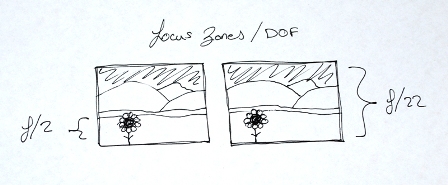Aperture
Your aperture is what I consider the most important part of creating an image. It is also the most limiting factor and is directly responsible for the depth of field, falloff and edge to edge sharpness of your picture.
The physical quantity that a lens’s aperture relates to is the flow of light through the diaphragm at that particular f-stop. In fact, much like the iris in your eye. It is measured by dividing the focal length with the maximum width at that given aperture. For example, a 50mm lens with a maximum aperture width of 35.7mm will have a maximum f-stop of f/1.4. This also means that f/1.4 on a 50mm lens should equal the exposure at f/1.4 on a 28mm lens. In short, the larger the aperture (smaller f-stop number) the greater the flow of light.

Depth of field (DOF) is the distance between the nearest and furthest points in an image which appear to be in focus. A large aperture like f/2 will give a narrow depth of field where as using a small one like f/22 will give a wide depth of field with most of the picture being in focus. A wide angle lens will also inherently have a greater DOF due to its design. The majority of landscape images are shot on tripods and stepped down to f/11-f/22 for maximum DOF. The trade off is the increased time need to make an exposure. Many cameras will have a DOF preview button so you can review your focusing before taking the shot. Alternatively, good lenses will have this scale marked on them.

Falloff is the darkening of the periphery of an image. It is one of the most artistic tools available and is a direct consequence of you aperture. The amount will differ between lenses with different maximum apertures and optical design (more evident in fast primes). The typical effect is shown below for a 50mm lens.

Edge to edge image sharpness is also affected by the choice of aperture, but not solely limiting. Quality and design of the lens (inclusion of aspherical elements etc) are the main contributors here. However, for most cases, when shooting at or near a lens’s maximum aperture the corners of your picture will appear less sharp than the center. This is not a big deal to worry about unless you are using wide angles and planning to print big. As it is, most people place the detailed parts of their photos near the center anyway.
All lenses will have an optimum aperture at which they will give an acceptably sharp image all over. It is not just a case of stopping down and all will go away because once you get to the likes of f/22 and beyond (particularly in large and medium format) you hit the realm of diffraction.
This brief ramble should give you enough understanding of a camera’s aperture and what it can do for you when taking your next picture.


